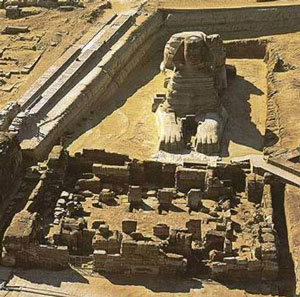
Fact File: The Pyramid of Khafre
Height: 143.5m (when first made)
Height: 136.4m (now)
Built for: Khafre, son of Khufu
Name: Khafre is Great
Date: around 2550BC
Width of each edge: 215m
Angle: 53°10'
Volume: 2,211,096 cubic metres
Made of: limestone, Tura limestone for the casing, and granite for the lowest level of casing

the top of Khafre's pyramid, with smooth casing stones
Khafre's pyramid from the corner
The Pyramid of Khafre and the Sphinx
Khafre was the son of Khufu. His pyramid stands next to Khufu's and appears to be taller, but this is because it stands on higher ground. In fact it was 10m shorter than Khufu's pyramid when it was first built, and even now that the Great Pyramid has lost some of its top, it is still 1m shorter.
Khafre's pyramid is similar to his father's except that it still has some of the smooth limestone casing on the top, which originally covered all the pyramids but which was stolen to build Cairo in medieval times. Also, its passages do not lead upwards to the burial chamber but downwards, to underground chambers. The outer stones were cut very finely, as with Khufu's pyramid, but inside, most of the blocks in the pyramid are very roughly cut.
Khafre's pyramid is also different because it still has its attached mortuary temple, as well as the valley temple and Great Sphinx about 500m away. In the mortuary temple was found a superb statue of the king made of diorite (see right). It shows him with the falcon god Horus enfolding him with his wings. Horus stood for the pharaoh, who was seen as Horus come down to earth in human form.
 Khafre's name means 'Appearing like Re'.
It is spelled out in the cartouche, left. From top to bottom:
Khafre's name means 'Appearing like Re'.
It is spelled out in the cartouche, left. From top to bottom:
Re (the sun god)
Kha (means 'appearing')
a (picture of an arm - makes an odd sound in throat, not really an 'a')
f (picture of a snake)
Re is
written first because it is a god's name.


Statue of Khafre
The Great Sphinx
The Great Sphinx is an enormous statue of a pharaoh - probaby Khafre - with a lion's body. It lies next to the Valley Temple and its own Sphinx Temple, 500m from Khafre's pyramid. It was carved from the bedrock and is 73m long and 20m high. The pharaoh is shown wearing his nemes headdress. The sphinx was probably painted, with yellow ochre for the body, red ochre for the face, and blue and yellow stripes for the headdress.

the sphinx, next to the sphinx temples and causeway
What is a sphinx?
The word sphinx is Greek, and may come from the Egyptian shesep ankh, which means 'living image'. It shows the pharaoh as a lion - a powerful beast with a mane which is similar to the headdress. It was a way to remember Khafre for all time as a powerful king. However the sphinx also stands for Ra, the sun god, or perhaps Horus, the sky god, and so it is showing Khafre as a god. Perhaps it was meant to guard the pyramids.
Sphinxes are found all over Egypt, usually with the head of a pharaoh, but they are much smaller statues (about 3m long).
The Sphinx Temple

The sphinx was worshipped in his own temple, now quite ruined. Later, in the New Kingdom, a new temple (just to the right of this picture) was built to the sphinx. The New Kingdom Egyptians identified the sphinx with the god Horemakhet - Horus on the Horizon. From earliest times, Ra and Horus were closely connected, both being shown as falcons and living in the sky.
Inside Khafre's Pyramid
Unlike the Great Pyramid, the passages in Khafre's pyramid lead down into the bedrock. At the end of the tunnels lies the burial chamber. It is 14m long, 5m wide, and nearly 7m high.
The sarcophagus is made of black, hard granite. It is half sunk into the floor and the lid was found brokn into two pieces. There is another pit cut into the floor which probably held the canopic chest - a box for the king's organs.

how the sphinx and temples might have looked in ancient times

plan of the sphinx, valley temple and sphinx temple
Temples: The Mortuary Temple
Khafre's mortuary temple was right next to the pyramid. It may have been where they mummified the king's body before burying him in the pyramid. Also, this is where the priests carried out ceremonies every day to worship the soul of the dead king. A causeway (covered walkway) led down to the Valley Temple and the Great Sphinx (you can see these is the background in the photo above).
plan of the mortuary temple
The temple was made of limestone and covered in pink granite. It had a courtyard with statues of the king. It is 110m long and 45m wide - a truly enormous temple.
The Valley Temple
At the end of the 494m causeway was another temple, the Valley Temple. This is where the body of the king arrived first, borne by a boat which landed at a quay in front of the temple (the remains of this quay have been found). It is made of limestone and huge, extemely well cut blocks of pink granite.







